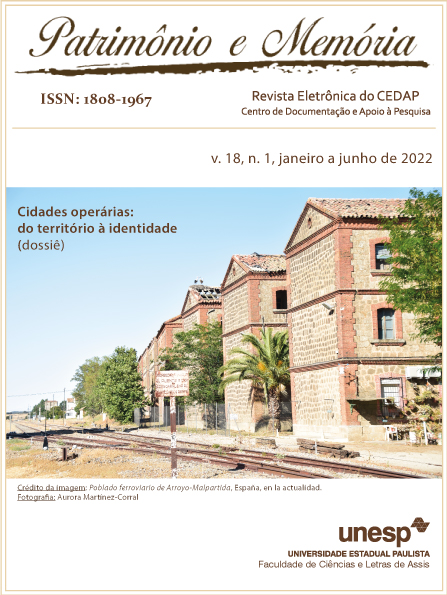Um caminho de ferro para o Barreiro
A railway to Barreiro
DOI:
https://doi.org/10.5016/pem.v18i1.2984Palavras-chave:
Caminho de ferro, Indústria, Barreiro, Patrimônio, ConversavaçãoResumo
No bojo do desenvolvimento ferroviário, paradigma de progresso e civilização, o governo português tinha como objetivo ligar a margem esquerda do Tejo até o Algarve. O Barreiro foi escolhido pela sua localização estratégica, devido a sua acessibilidade marítima e relativamente próximo de Lisboa. Foi a partir da implantação do caminho de ferro que se seguiu a instalação da indústria. A região então passou de um pequeno porto ligado à pesca fluvial para uma forte zona industrial, com expansão demográfica e urbanística com mais da metade da população a trabalhar com a atividade industrial. Em meados do século XX, o Barreiro era um dos maiores impérios industriais da Península Ibérica. Este artigo tem como objetivo discorrer sobre a transformação que desenvolveu no Barreiro fruto do crescimento ferroviário e industrial, assim como a construção de uma identidade local que atualmente busca ser salvaguardada através de entidades e associações de preservação local.
Referências
ASSOCIAÇÃO BARREIRO PATRIMÓNIO MEMÓRIA E FUTURO. Disponível em: https://associacaobarreiro patrimonio.pt - Acesso em 15/12/2018.
BIBLIOTECA NACIONAL DE PORTUGAL. A revolução de Septembro, n. 1, 22 jun. 1840, ao ano 60, n. 15031, 20 jan. 1901. Lisboa: Typ. J. B. da A. Gouveia, 1840-1901.
BLOG DO MOVIMENTO CÍVICO DE SALVAGUARDA DO PATRIMÓNIO FERROVIÁRIO DO BARREIRO. Dispónível em: http://patrimoniobarreiro.blogspot.com.
HEMEROTECA DIGITAL DA CÂMARA MUNICIPAL DE LISBOA. Disponível em: http://hemerotecadigital.cm-lisboa.pt.
O OCCIDENTE: Revista Illustrada de Portugal e do Estrangeiro. 7. ano, v. 7, n. 210, 21 out. 1884, p. 236. Disponível em: http://hemerotecadigital.cm-lisboa.pt/OBRAS/Ocidente/1884/N210/N210_item1/P4.html.
REVISTA FUNDIÇÃO. Associação Barreiro Património Memória e Futuro. Junho 2012, n. 1. Disponível em: https://issuu.com/associacaobarreiropatrimonio/docs/fundi__ __on1.
REVISTA FUNDIÇÃO. Associação Barreiro Património Memória e Futuro. Abril 2018, n. 6.
ALVES, R. M. V. Arquitetura, cidade e caminho de ferro: as transformações urbanas planeadas sob a influência do caminho de ferro. Coimbra, 2015. v. 1. Tese (Doutorado em Arquitetura) – Faculdade de Ciências e Tecnologia, Universidade de Coimbra.
CARMONA, R. A cultura ferroviária no Barreiro: 150 anos do Caminho-de-Ferro no Barreiro. In: COLÓQUIO INTERNACIONAL. Câmara Municipal do Barreiro. 2011.
CUÉLLAR, D. Railway towns: a long-term global perspective. Journal of History of Science and Technology, v. 12, p. 132-154, 2018. DOI: 10.2478/host-2018-0003.
CUSTÓDIO, J. (1990). O Património Industrial e os Trabalhadores. In I Encontro Nacional sobre o Património Industrial: Actas e Comunicações, Vol. II, Coimbra Editorial LDA.
DIREÇÃO GERAL DE PATRIMÓNIO CULTURAL. Parecer técnico Proposta de abertura do procedimento de classificação do Complexo Ferroviário do Barreiro. Lisboa, 2017.
FREIRE, M. E. L. Patrimônio ferroviário: a preservação para além das estações. Recife, 2017. Tese (Doutorado) – Universidde Federal de Pernamuco.
GONÇALVES, Nelson M. T. O primeiro plano de urbanização do Barreiro (1948-1957). 2013. Dissertação (Mestrado em História Moderna e Contemporânea) – Escola de Sociologia e Políticas Públicas, ISCTE-IUL
MARINA, C., Centro interpretativo do Estuário do Tejo Estação Barreiro-Mar. Revista Fundição, n. 6, 2018.
MARTINS, J.; Brion, M.; SOUSA, M. et al. O Caminho de Ferro revisitado: o Caminho de Ferro em Portugal de 1856 a 1996. Lisboa: Caminhos de Ferro Portugueses, 1996.
PEREIRA, H. S. As viagens ferroviárias em Portugal (1845-1896). Revista CITCEM, n. 1, 2010.
PEREIRA, H. S. A política ferroviária. Porto, 2012. Tese (Doutorado) – Faculdade de Letras, Universidade do Porto.
PEREIRA, H. S. Os caminhos-de-ferro de Sul e Sueste e o relatório do engenheiro C. F. White (1868). Évora: Publicações do Cidehus. DOI: 10.4000/books.cidehus.5439. Disponível em: https://books.openedition.org/cidehus/3391.
PIMENTA, J. A. Memória histórica e descriptiva da Villa do Barreiro. Lisboa: Typ. do Diccionário Universal Portuguez, 1886. Disponível em https://archive.org/details/memoriahistorica00pime/page/n5/mode/2up?q=rotunda. Acesso em: 20 jul. 2020.
SANTOS, Carla Marina. Estação Barreiro-Mar centro interpretativo do Estuário do Tejo. Revista Fundição, n. 9, 2020.
SANTOS, L. F. S. Os acessos a Faro e aos concelhos limítrofes na segunda metade do séc. XIX. Faro: Câmara Municipal de Faro, 1995.
SARAIVA, J. H.; GUERRA, M. Diário da história de Portugal. Lisboa: Difusão Cultural, 1998. v. 3.
Downloads
Publicado
Como Citar
Edição
Seção
Licença
Copyright (c) 2022 Breno Albuquerque Brandão Borges

Este trabalho está licenciado sob uma licença Creative Commons Attribution 4.0 International License.
Todo o conteúdo do periódico, exceto onde está identificado, está licenciado sob uma Licença Creative Commons do tipo atribuição BY.


